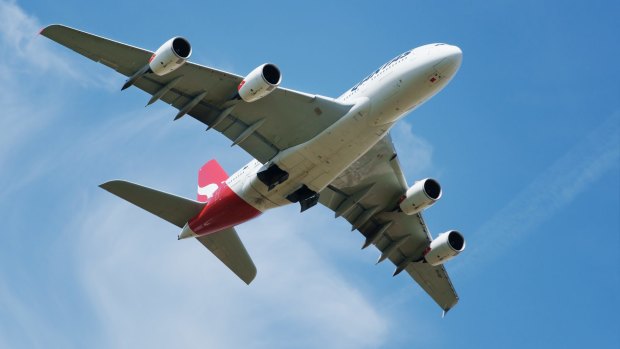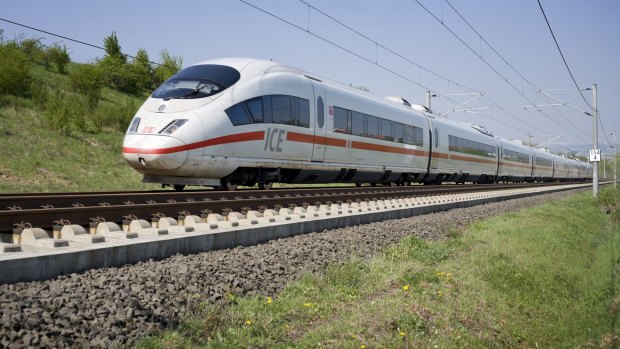This was published 4 years ago
'Flight shame' in Australia: Can we really travel without flying?

Other than staying home, Australians have few alternatives to flying - and some of those alternatives are even worse.Credit: iStock
Back in 2007, Swedish writer Stieg Larsson wrote a book with the title The Girl Who Kicked the Hornets' Nest.
Although he was more than a decade in front, that title would be a perfect fit for another great Swedish disruptor, Greta Thunberg, the environmental Joan of Arc and poster figure for "flygskam", flight shame. Thunberg didn't coin the phrase but her stance in preferring to take a train, a sailing boat or anything but a flight has galvanised a worldwide movement.
In choosing to fly, are we banging another nail in the environmental coffin? At a time where nature is speaking loud and clear and where the effects of climate change are becoming more and more apparent, the idea that what we do in the name of leisure and pleasure when we take a flight is contributing to the problem is a highly sensitive issue.

Greta Thunberg at the World Economic Forum (WEF) in Davos, Switzerland last month.Credit: Bloomberg
Especially for some Australians, since by virtue of our location we contribute more per capita to aviation industry CO2 emissions than just about any other nationality. Do we have viable alternatives?
The size of the problem
According to the International Air Transport Association (IATA), air travel accounts for about 2 per cent of the world's global carbon emissions. IATA expects air travel numbers to double by 2037, and therefore the aviation industry will be responsible for an increasing share of carbon emissions, assuming other industries remain constant.
While we can expect jet engines to become more efficient, and burn less fuel per passenger/kilometre over that period, it won't make much of a dent given the increasing passenger numbers.
Between 1960 and 2000 there was a 55 per cent gain in the fuel efficiency of jet aircraft, but most of that gain was made early. These days the rate at which jet engine technology delivers fuel efficiency gains is incremental.
To put aviation industry emissions into perspective, according to the Food and Agriculture Organization of the United Nations, energy production is the major contributor to global carbon emissions, accounting for about one third of all human-produced greenhouse gas.
Agriculture, forestry and other land use accounts for about one-quarter, industry 21 per cent and transport 6 per cent. The fashion industry is considered to be among the top five most polluting industries, responsible for more carbon emissions than aviation by a considerable margin. The finger of blame is pointed at fast fashion – low-cost labels that move quickly from catwalk to wardrobe to rubbish bin.
Rail

Credit: iStock
With just 41g of CO2 emissions per passenger/kilometre train travel is the gold standard. In terms of damage to the environment via CO2 emissions, it beats flying by a factor of four.
In Europe, with its fabulous, fast and frequent network of high-speed trains – mostly subsidised at huge cost by a population 25 times greater than our own and covering a landmass just 25 per cent greater than ours – rail travel is practical and cheap. The feelgood factor is the icing on the cake.
Given Australia's huge distances, a creaking railway system and the cost of train travel relative to flying, it takes fortitude to prefer train over air for even inter-capital journeys.
Ship
For anyone looking to reduce their carbon footprint, travel by ship might appear to be an attractive alternative but it's not straightforward.
Once upon a time it was not remarkable for anyone looking to travel from Australia to the UK or the USA to take a ship. That was back when John Farnham had a 6-week chart-topper called Sadie the Cleaning Lady, and it hasn't been popular for long-distance travel ever since.
While you could take a ship to most major cities with ocean frontage, sailings are far less frequent than airline flights, nor do ships travel speedily between your origin and destination but hop from one port to the next en route.
If you want to go from Melbourne to Los Angeles you'd probably find yourself stopping at New Zealand, Fiji and Hawaii. To Japan, you might call in at Brisbane, Cairns, the Philippines and Hong Kong. Who has the time?
According to figures from Griffith University, cruise ship emissions make up 0.2 per cent of all global carbon dioxide emissions. That's less than one-tenth the figure for air travel, but while cruise ships carried around 30 million passengers in 2019, that's fewer than 1 per cent of the number of airline passengers.
Figures from the International Council on Clean Transportation suggest that even the most efficient cruise ships emit three to four times more carbon dioxide per passenger-kilometre than jet-propelled air travel.
There's also the issue with the cheap and dirty fuel they burn. Many cruise ships use scrubbers which wash cheap fuel to comply with International Maritime Organisation standards, but they flush the pollutants collected from the scrubbers into the ocean. Same goes for the liquid waste from their sewerage treatment systems. If you're looking for greener alternative to air travel a cruise ship is not the answer.
Drive
According to the UK Government's figures for greenhouse gas reporting, an "upper medium" size car generates 217g of CO2 per kilometre. That's slightly more than one airline passenger generates per kilometre taking into consideration the secondary effects from high altitude, non-CO2 emissions.
However, stack that same car with four bodies and the emissions increase only marginally, which means each of those four people is responsible for just slightly more emissions than one train passenger. Nothing to feel bad about multi-passenger car travel for anyone looking to cut their emissions.
The tyranny of distance
Living on our remote island continent, our international flights are long. A flight from Sydney to Port Moresby, in Australia's closest neighbouring country, takes four hours. It's quicker to fly from London to Istanbul.
Giving up air travel in order to reduce our carbon emissions means going cold turkey as far as long-distance travel is concerned. For the overwhelming majority of Australians, the flight shaming issue is not going to fly.
In Sweden on the other hand, home of flygskam, ideas are changing. According to a 2019 World Wildlife Foundation survey, 23 per cent of Swedes said they did not travel by air in the past year for climate reasons, an increase from 17 per cent the previous year.
Sweden's state-owned airport operator Swedavia reported a 4 per cent drop in the number of passengers flying through its 10 airports in 2019. That's despite positive economic growth for that year, normally a spur for increased air travel.
However, while the number of domestic travellers was down by 10 per cent, the figure for international travel fell by just 2 per cent. That suggests some Swedes might alter their travel patterns and choose not to fly, but only when it's convenient.
As for Thunberg herself, she's been a polarising figure. She's single-handedly raised the collective blood pressure of Australia's shock jocks and faced down the US President and done it with style and dignity. In the face of those attacks she's shown grit and courage. Personally, I think she's a hero, and the world should be listening to what she has to say.
Sign up for the Traveller newsletter
The latest travel news, tips and inspiration delivered to your inbox. Sign up now.